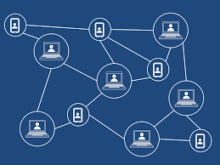Your guide star to innovation
 U of Guelph, Left investing $2.13 million in RightMesh project to improve Northern connectivity
U of Guelph, Left investing $2.13 million in RightMesh project to improve Northern connectivity
Left and the University of Guelph’s School of Computer Science have announced a $2.13 million partnership with non-profit Mitacs to put the power of connectivity into the hands of the North through RightMesh. The project will use mesh networking and blockchain technology to enable connectivity independent of the Internet in Northern communities.
Through this partnership, the RightMesh infrastructure will be implemented and community-identified and led mesh-based applications will be developed, such as messaging, emergency response, and environment and health monitoring. Advocates claim that mesh-networked applications will be critical to enabling Northern communities to deal with the effects of climate change in the face of limited Internet access.
University of Alberta Receives $2.5 Million to Open AI Hub
The University of Alberta has received a new $2.5 million grant to establish an Artificial Intelligence (AI) Supercomputing Hub for collaboration between academia and industry. The funding is being provided by Western Economic Diversification Canada, whose mandate is to strengthen the economy of Western Canada through investment in innovative businesses and communities.
The new AI Hub, equipped with high-performance computers, will be a training and development facility for AI and data science specialists in Western Canada. The new facility is intended to both raise Canada’s AI expertise as well as provide a workforce for emerging AI companies in the region.
Part of the funding will also go towards raising the profile of Western Canada’s AI industry at the upcoming AI and Interaction Digital Entertainment (AIIDE’18) International Conference.
https://techvibes.com/2018/11/16/university-of-alberta-receives-2-5-million-to-open-ai-hub
Milestone Experiment Proves Quantum Communication Really Is Faster 
A recent experiment out of Paris, France has demonstrated, for the first time, that quantum communication is superior to classical means. The French researchers showed that quantum computers can solve certain mathematical problems by transmitting less information than classical computers. This is done by using a single photon to carry multiple digital bits, then ‘smearing’ it across multiple pulses of light.
 Volkswagen Solves Quantum Chemistry Problems on a D-Wave quantum computer
Volkswagen Solves Quantum Chemistry Problems on a D-Wave quantum computer
Scientists at Volkswagen in Munich and San Francisco have used a D-Wave 2000Q quantum computer to solve rudimentary quantum chemistry problems. By running D-Wave computations they have discovered the ground state energies of molecular hydrogen and the molecule lithium hydride. The results are the fulfillment of scientists’ long-held dream of using such exotic machines to simulate quantum phenomena in atoms and molecules.
 Millimetre waves for the last mile
Millimetre waves for the last mile
Upcoming 5G networks will use millimetre-wave spectrum (the part of the radio spectrum above 30 gigahertz) to achieve +400 Gbps speeds. This speed, however, comes at a price: the high-frequency signals barely propagate around the corners of buildings. To overcome this, engineers at Vodafone propose making manhole covers do double duty as cell antennas. This solution would avoid all the issues that are anticipated with the proliferation of small 5G cells; no traffic disruptions from street construction and no ungainly antennas placed on buildings, marring the appearance of a neighborhood.

